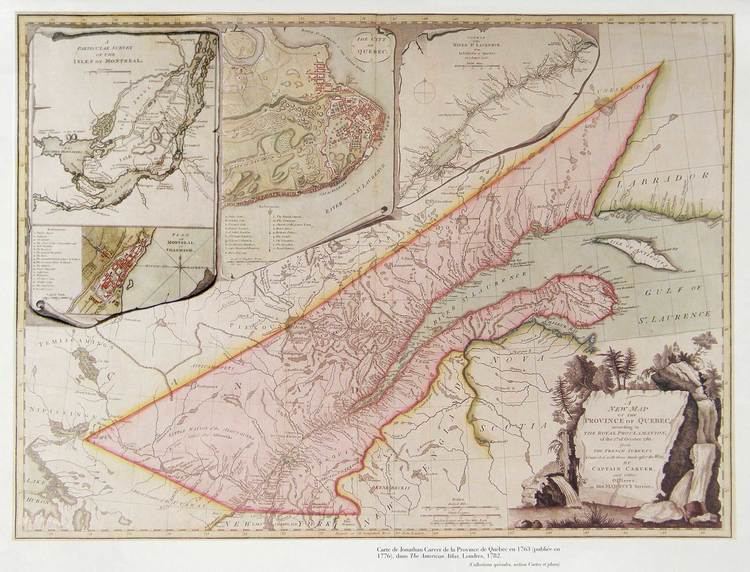Preceded by Succeeded by | Currency Canadian pound Founded 1763 Date dissolved 1791 | |
 | ||
Government Constitutional monarchy Today part of Canada (part of Ontario, Quebec and Labrador) United States (most of Ohio, Michigan, Indiana, Illinois, Wisconsin and Minnesota) | ||
Province of quebec 1763 91
The Province of Quebec was a colony in North America created by Great Britain after the Seven Years' War. Great Britain acquired French Canada by the Treaty of Paris in which (after a long debate) France negotiated to keep the small but very rich sugar island of Guadeloupe instead. By Britain's Royal Proclamation of 1763, Canada (part of New France) was renamed the Province of Quebec. The new British province extended from the coast of Labrador on the Atlantic Ocean, southwest through the Saint Lawrence River Valley to the Great Lakes and beyond to the confluence of the Ohio and Mississippi Rivers. Portions of its southwest (below the Great Lakes) were later ceded to the United States in a later Treaty of Paris (1783) at the conclusion of the American Revolution.
Contents
- Province of quebec 1763 91
- History
- Governors of the Province of Quebec 17631791
- Counsellors to the governor
- Geography
- References
History
Under the Proclamation, Quebec included the cities of Quebec and Montreal, as well as a zone surrounding them, but did not extend as far west as the Great Lakes or as far north as Rupert's Land.
In 1774, the British Parliament passed the Quebec Act that allowed Quebec to restore the use of French customary law ("Coutume de Paris") in private matters alongside the British common law system, and allowing the Catholic Church to collect tithes. The act also enlarged the boundaries of Quebec to include the Ohio Country and Illinois Country, from the Appalachian Mountains on the east, south to the Ohio River, west to the Mississippi River and north to the southern boundary of lands owned by the Hudson's Bay Company, or Rupert's Land.
Through Quebec, the British Crown retained access to the Ohio and Illinois Countries even after the Treaty of Paris, which was meant to have ceded this land to the United States. By well-established trade and military routes across the Great Lakes, the British continued to supply not only their own troops but a wide alliance of Native American nations through Detroit, Fort Niagara, Fort Michilimackinac, and so on, until these posts were turned over to the United States following the Jay Treaty (1794).
Quebec retained its seigneurial system after the conquest. Owing to an influx of Loyalist refugees from the American Revolutionary War, the demographics of Quebec came to shift and now included a substantial English-speaking, Anglican or Protestant element from the former Thirteen Colonies. These United Empire Loyalists settled mainly in the Eastern Townships, Montreal, and what was known then as the pays d'en haut (high country) west of the Ottawa River. The Constitutional Act of 1791 divided the colony in two at the Ottawa River, so that the western part (Upper Canada) could be under the British legal system, with English speakers in the majority. The eastern part was named Lower Canada.
Governors of the Province of Quebec 1763–1791
After the capitulation of Montreal in 1760, New France was placed under military government. Civil government was instituted in 1764. The following were the governors:
There were also "lieutenant governors", but these were merely the deputies of the governors, and should not be confused with the modern-day Lieutenant-Governor of Quebec.
Counsellors to the governor
The Province of Quebec did not have an elected legislature and was ruled directly by the governor with advice from counsellors. A council responsible to advise the governor (then James Murray) on all affairs of state was created in 1764. In 1774, the Quebec Act created a Council for the Affairs of the Province of Quebec to advise the governor on legislative affairs. The Legislative Council served as an advisory council to the governor until a legislative assembly was established after 1791.
The individuals James Murray called into the council from 1764 to 1766:
List of councillors under Carleton from 1766 to 1774:
Geography
Around 1763 to 1764 the province was divided into two judicial districts:
In 1790 the Trois-Rivières District was formed out of part of Quebec District.
The Trois-Rivières and Quebec districts continued after 1791 when Lower Canada came into existence, while Montreal District west of the Ottawa River became Upper Canada and east of the Ottawa River was partitioned into many electoral districts.
